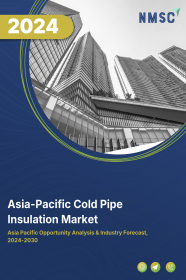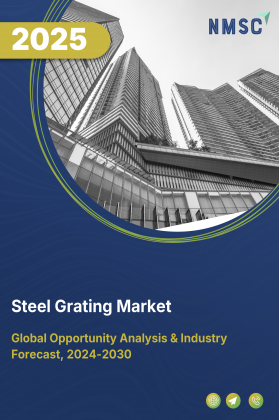
Asia-Pacific Cold Pipe Insulation Market by Material Type (Fiberglass, Foam Glass, Elastomeric Foam, Polyurethane Foam, Polystyrene Foam, Polyethylene Foam, and Rubber, and Other Materials), by Temperature Range (up to -18°C, -19°C to -180°C, -181°C to -210°C, and Less Than -210°C), by Application (HVAC, Refrigeration, and Cryogenic), and by End-User Industry (Oil & Gas, Chemicals, Food Processing, Pharmaceuticals, and Others) – Global Opportunity Analysis and Industry Forecast, 2023–2030
Industry: Materials and Chemical | Publish Date: 30-Nov-2024 | No of Pages: 217 | No. of Tables: 145 | No. of Figures: 103 | Format: PDF | Report Code : MC363
Market Overview:
The global Asia-Pacific Cold Pipe Insulation Market size was valued at USD 2.23 billion in 2022, and is predicted to reach USD 4.10 billion by 2030, with a CAGR of 7.1% from 2023 to 2030. Cold pipe insulation refers to the process of covering pipes that carry cold substances or fluids with a material to prevent heat transfer. The purpose of this insulation is to keep the cold fluid inside the pipe at a low temperature by minimizing heat gain from the surrounding environment.
Cold pipe insulation typically uses materials such as foam, fiberglass, or rubber. These materials create a barrier that helps maintain the temperature of the cold fluid, preventing it from warming up as it travels through the pipe. Insulating the pipe improves energy efficiency, as less energy is required to keep the fluid cold. Additionally, cold pipe insulation helps prevent condensation on the pipe's surface, reducing the risk of corrosion and damage to the surrounding area.
Growing Government Initiative for Energy-Efficient Solutions
Increasing government initiatives and stringent regulations focused on energy efficiency propel the growth of the Asia-Pacific cold pipe insulation market. Governments of countries in this region are implementing policies, regulations, and financial incentives to encourage businesses to adopt energy-efficient practices and meet specific standards. These initiatives are driving the demand for effective cold pipe insulation solutions as businesses aim to reduce energy consumption, lower costs, and contribute to environmental sustainability.
The expanding trends of urbanization and industrialization strongly influence the growth of the cold pipe insulation market in the Asia-Pacific region. As urban areas continue to expand and industrial activities thrive, the demand for various infrastructure and facilities increases. This includes the need for efficient heating, ventilation, and air conditioning (HVAC) systems and the demand for insulation solutions to minimize energy loss and optimize thermal efficiency.
The rapid growth of urban centers and the continuous development of industries create a significant market opportunity for cold pipe insulation. This is due to businesses and infrastructure developers seeking effective solutions to ensure energy efficiency, reduce operational costs, and promote sustainable practices.
The growing oil and gas industry in South Asian countries is a key driver behind the expansion of the cold pipe insulation market in the Asia-Pacific region. As the demand for oil and gas continues to rise, driven by factors such as population growth, industrialization, and increasing energy consumption, there is a corresponding need for effective insulation solutions in this sector.
Cold pipe insulation plays a crucial role in maintaining the integrity and efficiency of oil and gas infrastructure, including pipelines, tanks, and equipment. Insulating these components minimizes energy loss, preventing heat transfer and ensuring optimal operational performance.
Moreover, insulation helps mitigate risks associated with temperature fluctuations, corrosion, and condensation, enhancing the overall safety and longevity of oil and gas facilities. As the oil and gas industry expands, the demand for cold pipe insulation solutions is anticipated to grow steadily in order to meet the specific needs and requirements of this dynamic sector.
The High Cost Associated with the Installation of Insulation Systems Hinders Market Growth
A considerable initial investment is required for installing insulation systems. Moreover, the expenses associated with specialized equipment, skilled labor, and high-quality materials contribute to the high costs of implementing cold pipe insulation. Additionally, the ongoing maintenance and repair costs further add to the total cost. As a result, this cost barrier poses challenges, particularly for smaller businesses or projects operating within constrained budgets. This, in turn, hinders the growth prospects of the market for Asia-Pacific cold pipe insulation.
Introduction of New Insulation Technologies to Create Future Market Prospects
The cold pipe insulation market in Asia-Pacific is expected to experience significant growth in the near future, owing to the introduction of innovative technologies such as aerogels and graphite powder additives. These advanced insulation solutions offer several benefits, such as lightweight and thin nature, improved thermal performance, and cost-effectiveness.
Using aerogels and graphite powder additives makes energy conservation more efficient, and the overall thickness and weight of the insulation system are minimized. These materials not only provide installation flexibility but also reduce material costs. As businesses and industries increasingly look for affordable and sustainable insulation options, the emergence of these new technologies is predicted to boost the adoption of cold pipe insulation and drive market growth in the coming years.
Geographical Analysis
China holds a significant share of the Asia-Pacific cold pipe insulation industry, and is poised to maintain its dominance throughout the forecast period. This is attributed to several factors, including government initiatives and the growth of various industries such as oil & gas, manufacturing, power generation, and chemicals. The Chinese Government launched several initiatives to upgrade its industrial capability and smart manufacturing. It aims to drive innovation, product quality, efficiency, and integration across various industries.
For instance, the "Made in China 2025" initiative aims to enhance the country's current manufacturing industry with advanced technologies such as artificial intelligence (AI), cloud computing, and the internet of things (IoT). These technologies will help improve the efficiency and effectiveness of various industries by providing improved data analysis, monitoring, and automation capabilities. This will lead to a greater demand for energy-saving products, such as cold pipe insulation, as companies strive to improve their energy efficiency and reduce their carbon footprint. These initiatives highlight the importance of energy efficiency and sustainable development in the industrial sector, creating lucrative opportunities for the cold pipe insulation market.
Moreover, the increasing number of nuclear power plants in China requires efficient and safe insulation solutions to maintain the proper functioning of the plants. Cold pipe insulation is a crucial component in these facilities as it helps maintain the temperature and reduce energy loss while transporting fluids and gases. This, in turn, propels the growth of the market. According to Foro Nuclear, a non-profit organization dedicated to promoting the peaceful use of nuclear energy and supporting the development of nuclear technology, China is now the world's largest manufacturer of nuclear reactors. With 53 operational units and 16 more currently under construction, the country's expanding nuclear industry creates a growing demand for cold pipe insulation.
On the other hand, Malaysia is expected to show a steady rise in the Asia-Pacific cold pipe insulation market, owing to various initiatives by the Malaysian government towards energy conservation and sustainable energy. For instance, the Malaysian government announced a new target of achieving 31% renewable energy by 2025, 11% more compared to the current ambitious target set by the previous Pakatan Harapan Government.
Additionally, the thriving oil and gas industry in Malaysia is a prominent driving factor for the cold pipe insulation market in the country. With Malaysia being a significant producer and exporter of oil & natural gas, there is a growing need for efficient and reliable insulation solutions to maintain the optimal operation of oil and gas facilities. According to the U.S. Energy Information Administration report published on January 2021, Malaysia is the Southeast Asia's second-largest oil & natural gas producer and the fifth-largest exporter of liquefied natural gas (LNG) globally.
The Asia-Pacific cold pipe insulation industry includes various market players including Nichias Corporation, DuPont, BASF SE, Covestro AG, 3M, L'Isolante K-Flex S.p.A., Daikin Industries Ltd., Supreme Industries Limited, Owens Corning, Armacell International S.A., Insulflex Corporation Sdn Bhd, Ematco Industrial Pte. Ltd, Superlon Holdings, Insafoam, and Dongsung Chemical Co. Ltd. These companies are adopting various strategies to remain dominant in Asia-Pacific cold pipe insulation industry.
For Instance, in February 2023, Saint Gobain acquired U.P. Twiga Fiberglass Ltd., a glasswool insulation manufacturer in India. The acquisition enables the company to expand its range of insulation solutions, including cold pipe insulation, to meet the growing demand in the Asian market. This strategic acquisition serves as a catalyst for the growth of the cold pipe insulation industry in the Asian region.
Moreover, in July 2022, Armacell acquired Izolir, a Croatian pre-insulated pipe manufacturer. This strategic acquisition will allow Armacell to broaden its range of offerings and strengthen its expertise specifically in the pre-insulated cold pipe segment. With this expansion of its product portfolio and enhanced capabilities, Armacell is well-positioned to cater to the increasing demand for cold pipe insulation solutions.
In addition, in February 2021, BASF SE launched a new industrial pipe insulation product called Slentex at its manufacturing plant in Ulsan, South Korea. Slentex is a high-performance insulation material that offers excellent thermal conductivity, and can reduce energy consumption in industrial processes. The innovative product is made of aerogel, a lightweight and highly porous material that provides exceptional insulation properties.
Asia-Pacific Cold Pipe Insulation Market Key Segments
By Material Type
-
Fiberglass
-
Foam Glass
-
Elastomeric Foam
-
Polyurethane Foam
-
Polystyrene Foam
-
Polyethylene Foam
-
Rubber
-
Other Materials
By Temperature Range
-
Up To -18°C
-
-19°C To -180°C
-
-181°C To -210°C
-
Less Than -210°C
By Application
-
HVAC
-
Refrigeration
-
Cryogenic
By End-User Industry
-
Oil & Gas
-
Chemicals
-
Food Processing
-
Pharmaceuticals
-
Others
By Country
-
China
-
Japan
-
India
-
South Korea
-
Australia
-
Indonesia
-
Singapore
-
Taiwan
-
Thailand
-
Malaysia
-
Philippines
-
Vietnam
-
Rest of Asia-Pacific
Key Players:
-
Nichias Corporation
-
DuPont
-
BASF SE
-
Covestro AG
-
3M
-
L'Isolante K-Flex S.p.A.
-
Daikin Industries Ltd.
-
Supreme Industries Limited
-
Owens Corning
-
Armacell International S.A.
-
Insulflex Corporation Sdn Bhd
-
Ematco Industrial Pte. Ltd
-
Superlon Holdings
-
Insafoam
-
Dongsung Chemical Co. Ltd
REPORT SCOPE AND SEGMENTATION:
|
Parameters |
Details |
|
Market Size in 2022 |
USD 2.23 Billion |
|
Revenue Forecast in 2030 |
USD 4.10 Billion |
|
Growth Rate |
CAGR of 7.1% from 2023 to 2030 |
|
Analysis Period |
2022–2030 |
|
Base Year Considered |
2022 |
|
Forecast Period |
2023–2030 |
|
Market Size Estimation |
Billion (USD) |
|
Growth Factors |
Growing government initiatives for energy-efficient solutions Rapidly growing urbanization & industrialization Growing oil & gas industry in the region |
|
Countries Covered |
13 |
|
Companies Profiled |
15 |
|
Market Share |
Available for 10 companies |
|
Customization Scope |
Free customization (equivalent up to 80 working hours of analysts) after purchase. Addition or alteration to country, regional, and segment scope. |
|
Pricing and Purchase Options |
Avail customized purchase options to meet your exact research needs. |




















 Speak to Our Analyst
Speak to Our Analyst

























